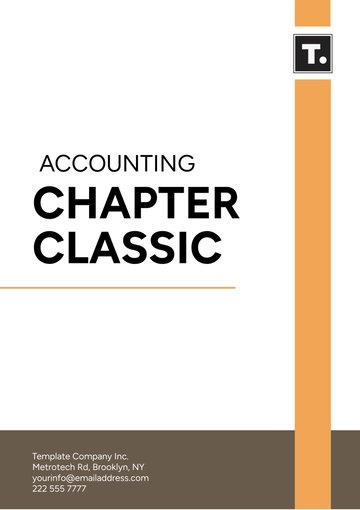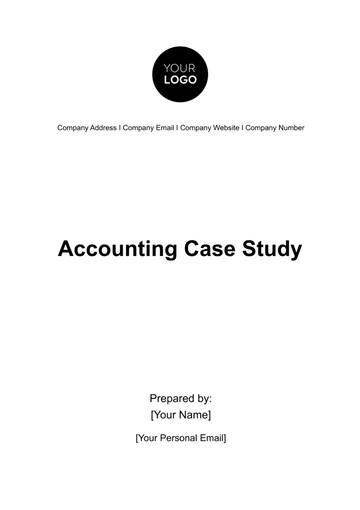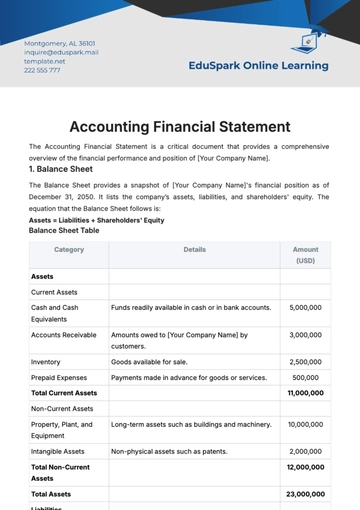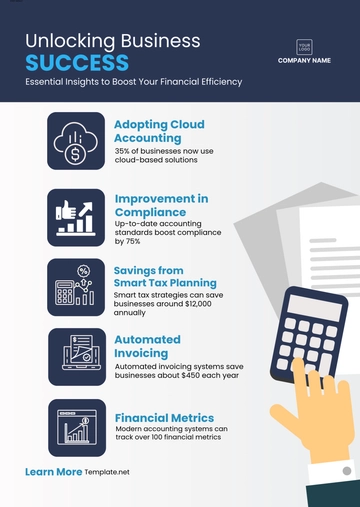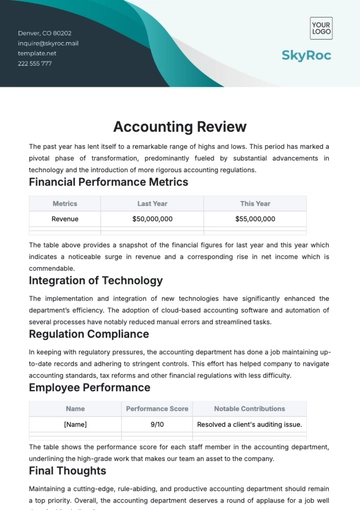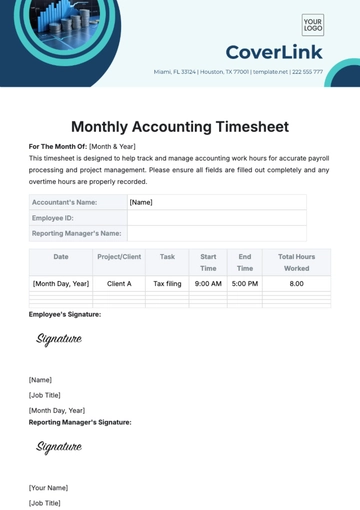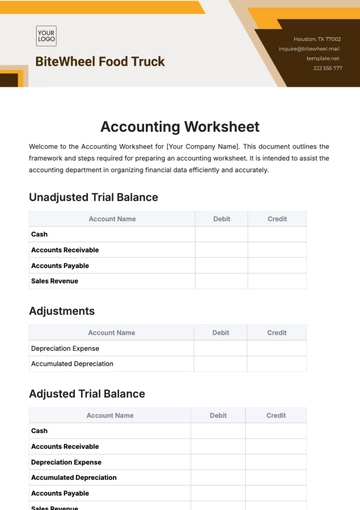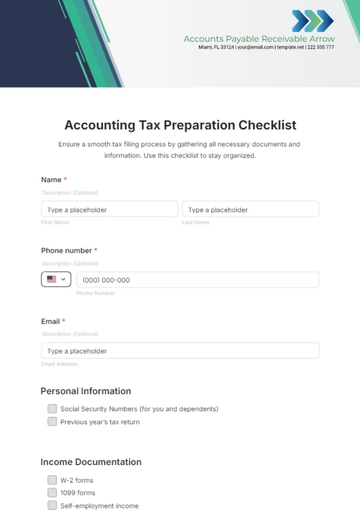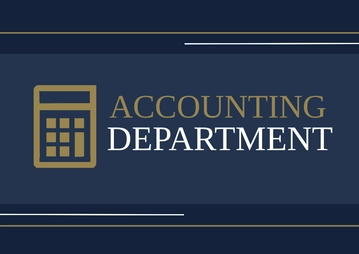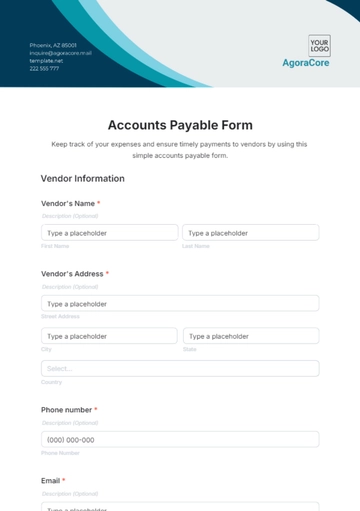Free Account Impact Study
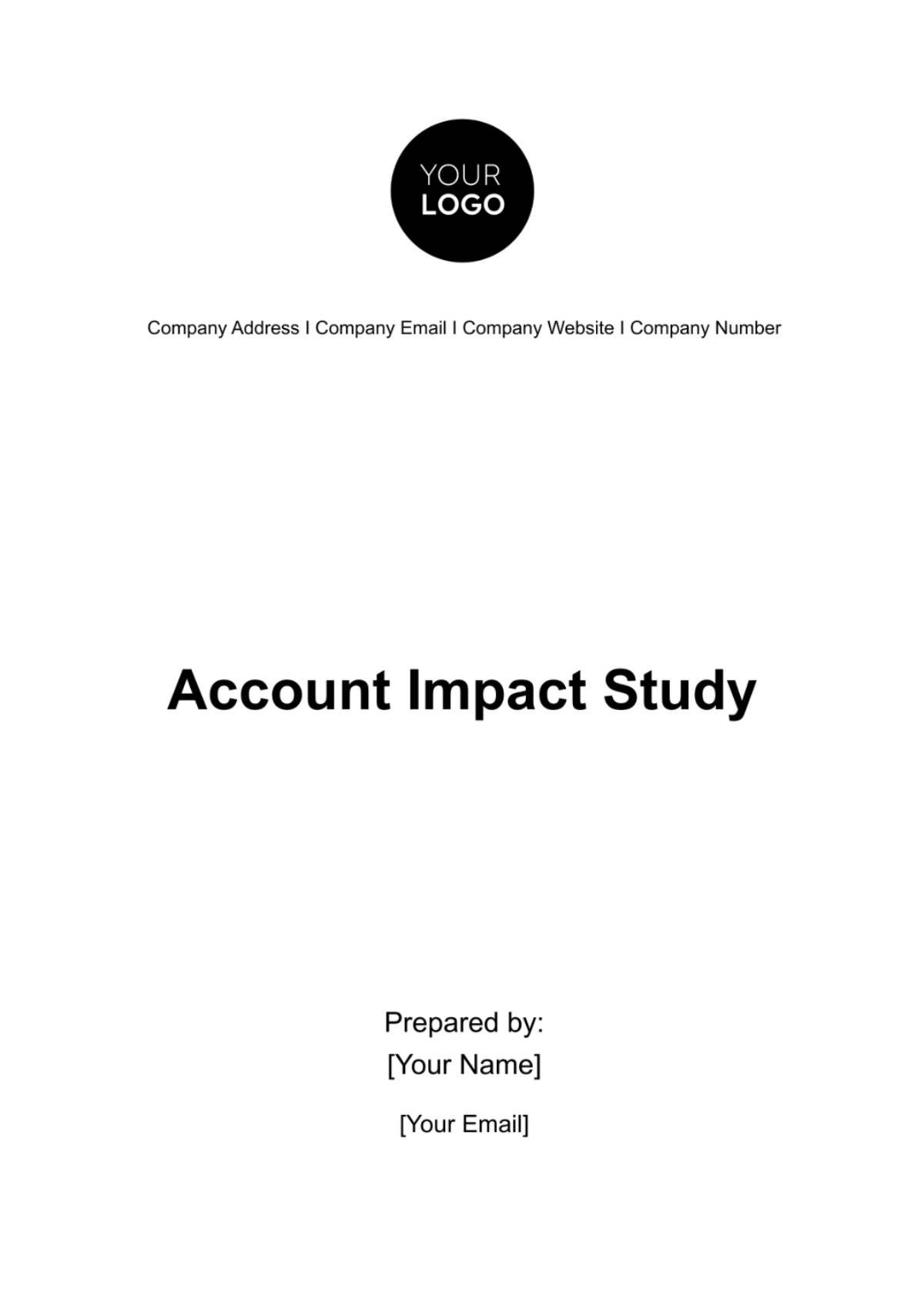
TABLE OF CONTENTS
Introduction...............................................................................................................3
Methodology.............................................................................................................4
Financial Performance Metrics................................................................................5
Findings and Analysis...............................................................................................7
Recommendations....................................................................................................9
Conclusion.................................................................................................................10
Introduction
This study aims to explore how good accounting practices impact [Your Company Name]'s profits, stability, and growth. We'll look at various aspects like how they do accounting, taxes, budgeting, and manage assets, along with the role of external auditors. The goal is to understand how these things affect [Your Company Name]'s overall performance.
[Your Company Name]'s Accounting Practices
In this study of [Your Company Name]'s accounting practices, we will provide a detailed account of the specific methods and procedures the company employs to manage its financial records effectively.
Adherence to Accounting Standards:
[Your Company Name] maintains a strict commitment to adhering to well-established accounting standards, including Generally Accepted Accounting Principles (GAAP) and International Financial Reporting Standards (IFRS). This ensures that the company's financial reporting is consistent, transparent, and compliant with industry norms.
Modern Accounting Software:
To streamline the handling of financial data, [Your Company Name] relies on contemporary accounting software tools. These software solutions enable efficient data entry, processing, and reporting. By automating routine tasks, the company minimizes the risk of errors and enhances operational efficiency.
Financial Data Security:
[Your Company Name] places a strong emphasis on data security. Robust measures are in place to safeguard financial data from unauthorized access or breaches. This includes encryption protocols, access controls, and regular audits to ensure the integrity and confidentiality of financial information.
Periodic Financial Reporting:
The company follows a well-defined schedule for periodic financial reporting. This includes the preparation of financial statements such as income statements, balance sheets, and cash flow statements. Timely reporting provides stakeholders with a clear view of the company's financial health.
Taxation Strategies for Financial Well-being
In this section, we will delve into the specific strategies and practices that [Your Company Name] employs to navigate the complex terrain of taxation for the sake of its financial well-being.
Tax Compliance:
[Your Company Name] rigorously adheres to all relevant tax regulations at the federal, state, and local levels. This includes timely filing of tax returns, accurate reporting of income, and adherence to tax deadlines. The company ensures full compliance to avoid legal issues and penalties.
Comprehensive Adherence: [Your Company Name] diligently follows and complies with tax regulations at various levels. This includes federal, state, and local tax codes, ensuring a comprehensive approach to tax compliance.
Timely Filing: The company places a premium on the timely filing of tax returns. Meeting tax deadlines is a priority, as late filings can result in penalties and interest charges.
Accurate Income Reporting: Ensuring the accuracy of income reporting is paramount. [Your Company Name] takes measures to meticulously report all income sources and transactions, leaving no room for discrepancies.
Risk Mitigation: By adhering to tax regulations, the company mitigates the risk of audits, legal issues, and penalties. This adherence contributes to a stable and legally compliant financial environment.
Tax Benefit Utilization:
[Your Company Name] actively seeks opportunities to leverage tax benefits, credits, incentives, and deductions provided by tax laws. This strategic approach minimizes the overall tax burden and maximizes the company's after-tax profits.
Strategic Pursuit: The company proactively seeks and identifies tax benefits, credits, incentives, and deductions that apply to its operations and industry. This proactive approach ensures that no potential tax-saving opportunity is overlooked.
Financial Optimization: By capitalizing on available tax benefits, [Your Company Name] optimizes its financial performance. This leads to increased after-tax profits, which can be reinvested in the business or distributed to stakeholders.
Compliance: While pursuing tax benefits, the company maintains strict compliance with tax laws. It ensures that all claims for benefits are legitimate and supported by proper documentation, reducing the risk of audits or legal issues.
Competitive Advantage: Leveraging tax benefits not only enhances financial performance but also provides a competitive advantage. It allows [Your Company Name] to allocate resources more efficiently, potentially reducing costs and offering more competitive pricing.
Tax Risk Mitigation:
Proactive risk management is a core element of [Your Company Name]'s tax strategy. The company conducts regular assessments of potential tax risks and vulnerabilities. Strategies are then developed to mitigate these risks, ensuring a stable financial position and safeguarding against unforeseen tax liabilities.
Risk Assessment: [Your Company Name] conducts periodic assessments to identify potential tax risks and vulnerabilities. This includes analyzing changes in tax laws, industry-specific risks, and potential compliance challenges.
Strategic Measures: Upon identifying tax risks, the company formulates and implements strategic measures to mitigate them. These measures may include adjusting business practices, revising tax strategies, or seeking expert guidance.
Legal Compliance: While mitigating risks, [Your Company Name] remains committed to legal compliance. Strategies are designed to align with tax regulations while minimizing exposure to unforeseen liabilities.
Stability Assurance: Proactive tax risk mitigation ensures the stability of [Your Company Name]'s financial position. It safeguards against unexpected financial setbacks and maintains investor and stakeholder confidence.
International Taxation:
[Your Company Name] has a comprehensive approach to international taxation, considering aspects like transfer pricing, cross-border transactions, and foreign tax credits. This ensures efficient management of taxes in a global business environment.
Global Operations: [Your Company Name] conducts business on a global scale, necessitating a comprehensive approach to international taxation. This includes considering the tax implications of cross-border operations and transactions.
Transfer Pricing: The company carefully manages transfer pricing to ensure compliance with international tax laws and to optimize tax outcomes in various jurisdictions.
Foreign Tax Credits: [Your Company Name] seeks to maximize foreign tax credits to avoid double taxation and optimize its global tax position.
Compliance: International taxation involves complex regulations and compliance requirements. The company places a strong emphasis on adhering to these regulations to avoid legal issues and penalties while optimizing its global tax position.
Global Responsibility: [Your Company Name]'s approach to international taxation reflects its commitment to responsible and ethical global business practices. It ensures that the company operates in compliance with the tax laws of each country in which it conducts business.
By implementing these accounting practices and tax strategies, [Your Company Name] not only ensures financial stability but also fosters resilience and adaptability in an ever-changing financial landscape, ultimately contributing to its long-term success.
Methodology
The methodology employed in this study is designed to provide a thorough and rigorous examination of [Your Company Name]'s financial operations and the efficacy of its accounting practices. A multi-faceted approach was adopted, encompassing the following key methods:
Stakeholder Interviews:
To gain valuable insights into the inner workings of [Your Company Name], interviews were conducted with key stakeholders within the organization. These interviews allowed for a firsthand understanding of the company's accounting processes, challenges, and strategic objectives. Insights from individuals directly involved in financial management provide a crucial qualitative perspective.
Audited Financial Statement Review:
An in-depth review of audited financial statements played a pivotal role in this study. These financial statements, subject to external audit scrutiny, serve as a reliable source of objective data. By analyzing these statements, we were able to assess the accuracy, transparency, and compliance of financial reporting.
Extensive Literature Review:
Extensive research was undertaken through a thorough literature review. This involved studying relevant academic papers, industry publications, and best practices in accounting. The literature review served as a foundation for benchmarking [Your Company Name]'s accounting practices against industry standards and identifying areas of improvement.
Key Performance Indicators (KPIs):
Key performance indicators (KPIs) were carefully selected and analyzed to gauge [Your Company Name]'s financial position and the effectiveness of its accounting systems and processes. These KPIs include but are not limited to financial ratios, liquidity metrics, profitability indicators, and efficiency ratios. By examining these KPIs, we assessed the company's financial health and the impact of accounting practices on its overall performance.
This methodology ensures a holistic evaluation of [Your Company Name]'s financial framework, taking into account both qualitative and quantitative aspects. By triangulating data from interviews, audited financial statements, literature review, and KPI analysis, this study provides a robust foundation for making informed recommendations to enhance financial performance and accounting practices.
Financial Performance Metrics
This section provides a detailed analysis of key financial performance metrics for [Your Company Name]. These metrics offer insights into the company's financial health and can serve as vital indicators of its overall performance. The table below presents the data for these metrics:
Performance for the Current Year [2051]:
Metric | Data Gathered |
|---|---|
Revenue | $50,000,0000 |
Performance for the Previous Year [2050]:
Metric | Data Gathered |
|---|---|
Revenue | $45,000,0000 |
Analysis:
Revenue:
The data reveals that [Your Company Name] achieved a total revenue of [$50,000,000] in the current year, marking a [10%] increase compared to the previous year. This substantial revenue growth reflects the company's effectiveness in expanding its market reach, increasing sales, or potentially introducing new revenue streams. It demonstrates a positive trend in [Your Company Name]'s ability to generate income.
Net Profit Margin:
[Your Company Name] has displayed a robust net profit margin of [15%] in the current year, showcasing an improvement over the previous year's [18%]. This signifies efficient cost management, increased operational effectiveness, or potentially higher pricing strategies, all contributing to enhanced profitability. The upward trajectory in net profit margin is an encouraging sign for stakeholders.
Return on Assets:
With a return on assets of [10%] in the current year, [Your Company Name] demonstrates its proficiency in efficiently utilizing its assets to generate profits. This percentage increase from the previous year's [8%] indicates a more effective deployment of investments in assets, leading to improved earnings generation.
Debt-to-Equity Ratio:
[Your Company Name] has successfully maintained a low debt-to-equity ratio of [1.1], signaling a prudent approach to financial leverage. This balanced ratio suggests that [Your Company Name] has been cautious in managing its debt levels relative to its equity, reducing financial risk. Such a healthy ratio is reassuring for investors and creditors alike.
Current Ratio:
[Your Company Name] exhibits a current ratio above [1.0], signifying a healthy liquidity position. With a current ratio of [1.2], the company possesses sufficient current assets to cover its current liabilities. This implies that [Your Company Name] can meet its short-term financial obligations without difficulty, providing financial stability.
Earnings per Share:
The earnings per share (EPS) for [Your Company Name] stands at [$500,000], reflecting the profit attributed to each outstanding share of common stock. The increase in EPS from the previous year's [$450,000] to the current year's figure is indicative of enhanced earnings generation, potentially due to improved operational performance or other factors. This growth in EPS can bolster investor confidence and contribute to stock value appreciation.
The data analysis demonstrates that [Your Company Name] has made significant strides in its financial performance. It has achieved impressive revenue growth, enhanced profitability, efficient asset utilization, prudent financial leverage, strong liquidity, and increased earnings per share. These positive trends underscore the company's commitment to financial excellence and position it favorably for sustained growth and continued success in the marketplace.
Findings and Analysis
The following table presents a concise summary of the key findings and impacts of effective accounting practices within [Your Company Name]. These findings highlight the pivotal role of accounting in various facets of the organization, including accounting processes, taxation, financial forecasting, asset management, and the role of external auditors. The impacts outlined below underscore the significance of sound accounting practices in driving efficiency, transparency, and financial well-being.
Category | Impact |
|---|---|
Accounting Processes | Enhanced operational efficiency through streamlined financial functions. Increased transparency in financial operations, fostering trust among stakeholders. Maintained a high degree of consistency in financial reporting, supporting informed decision-making. |
Taxation | Expert handling of tax responsibilities resulted in significant cost savings. Proactive tax compliance to avoid legal issues and penalties. |
Financial Forecasting | Invaluable tool for informed decision-making and strategic planning. Facilitated efficient resource allocation through accurate predictions. |
Asset Management | Improved asset control, leading to cost savings and financial health. |
Role of External Auditors | Increased investor trust and confidence through transparent financial reporting. |
The data presented in this table reinforces the crucial role of effective accounting practices in driving success across multiple dimensions within [Your Company Name]. It serves as a testament to the fundamental importance of accounting in promoting efficiency, financial stability, and stakeholder confidence.
Recommendations
Based on the comprehensive analysis of [Your Company Name]'s accounting practices and their impact on various aspects of the organization, the following recommendations are put forth to further enhance financial performance and ensure sustained growth:
Continuous Process Improvement:
It is advisable for [Your Company Name] to continually assess and refine its accounting processes. Embracing emerging technologies and best practices can further enhance efficiency and accuracy in financial operations. Regular training for accounting staff to stay updated with evolving standards and software tools is essential.
Tax Optimization Strategies:
To maximize tax savings while maintaining compliance, [Your Company Name] should consider engaging tax experts or consultants. Their expertise can help identify additional tax-saving opportunities and ensure adherence to changing tax regulations.
Robust Financial Forecasting:
Strengthening financial forecasting capabilities is recommended. Investing in advanced forecasting models and data analytics can provide more precise insights for decision-making, helping [Your Company Name] to allocate resources effectively and anticipate financial challenges.
Asset Management Framework:
Developing a comprehensive asset management framework can further optimize asset control. Regular asset audits and tracking mechanisms should be implemented to minimize losses and maximize resource utilization.
Ongoing Collaboration with External Auditors:
[Your Company Name] should continue to maintain a cooperative relationship with external auditors. Timely communication and cooperation with auditors can facilitate a smoother audit process and ensure the accuracy and transparency of financial statements.
Compliance Monitoring:
Establishing a dedicated compliance monitoring system to keep abreast of changing accounting and tax regulations is crucial. Regular internal audits can help identify and rectify compliance gaps promptly.
Stakeholder Communication:
Enhanced communication with stakeholders, including shareholders and investors, is recommended. Providing clear and concise financial reports and explanations of accounting practices can further boost confidence and transparency.
Long-Term Strategy:
It is imperative to formulate a comprehensive, long-term accounting and financial strategy that aligns seamlessly with [Your Company Name]'s overarching business objectives, ensuring sustainable financial health and strategic alignment for years to come.
Risk Management:
Strengthen risk management practices by identifying potential accounting and financial risks. Implement proactive measures to mitigate these risks and ensure financial stability.
Training and Development:
Invest in ongoing training and development programs for the accounting team to stay current with industry trends and regulatory changes. This will empower the team to adapt quickly to new challenges and opportunities.
These recommendations, when implemented thoughtfully, will contribute to [Your Company Name]'s sustained financial health, efficiency, and transparency, ultimately positioning the organization for continued success in the ever-evolving business environment.
Conclusion
The findings of this research demonstrate that the adoption and commitment to robust accounting practices have a pronounced and positive impact on an organization's profitability, solvency, and growth. The effective implementation of sound accounting processes has not only streamlined [Your Company Name]'s business operations but has also optimized the allocation of resources while ensuring steadfast compliance with regulatory requirements. These transformative changes have, in turn, substantially bolstered [Your Company Name]'s profit margins and instilled unwavering confidence among its stakeholders.
- 100% Customizable, free editor
- Access 1 Million+ Templates, photo’s & graphics
- Download or share as a template
- Click and replace photos, graphics, text, backgrounds
- Resize, crop, AI write & more
- Access advanced editor
Our Account Impact Study Template from Template.net is a highly customizable resource. Tailor your business documents to meet your specific needs with the editable feature of the template. Infuse your unique perspective by editing the content using our efficient Ai Editor Tool. Discover a seamless way of creating impactful account analyses with our fully editable and customizable templates.





